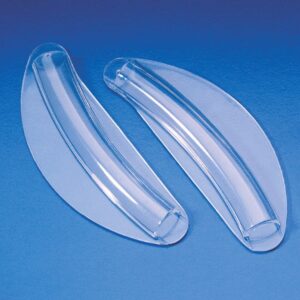There is no obstacle for my patients who feel well and want to be discharged on the day of the operation. Nevertheless, most people prefer to spend the night of the operation in hospital. During this time, I recommend resting with the head in an elevated position and applying ice. What you must remember: The better you rest, the faster and more trouble-free your healing will be. Therefore, your most important task after surgery is to rest.
One of the issues that is frequently abused and used for marketing purposes is the choice of surgeons to put or not to put a silicone plaque in the nose. I want you to know that it is a preference not to put the silicone plaques. So, it has no relation with the surgeon performing the operation better. We are not obliged to put the silicone plaques at the end of the operation, and I can choose not to do so if I want. However, in most cases (not always) I feel safer using these plaques, so I use them. I think they reduce the risk of bleeding and provide an advantage in maintaining the new shape of the nose. These are not rules and in some operations I may not need it and may not use it. However, I do not prefer to push the limits and take risks by promising “tampon-free nose surgery”. Although intranasal silicones make breathing a little difficult, they do not prevent it completely, and regular application of the ocean water solutions I recommend for cleaning makes it possible to keep your nose breathable. Breathing through your nose as much as possible and keeping it clean by washing the inside of the nose will help you have a more comfortable healing process. You can find a photo of the flexible and slippery plaques below.

Although the removal of plaster, bandage and intranasal silicones used for support after Rhinoplasty may vary from person to person, it is usually performed in the 1st week.
Contrary to popular belief, this procedure is often surprisingly painless. An example of the intranasal silicones I mentioned is in the photo below. Flexible and soft silicones slide easily and can be removed without discomfort.
There are many factors that have an effect on the formation of swelling and bruises. The method used by your surgeon, i.e., me, and my courtesy during the operation is one of them and I would like you to know that I am very sensitive in this regard. Another important factor is your skin structure. If you have easily bruised and swollen skin, the likelihood of similar problems is of course high.
Based on my experience, I can say that more than half of the patients overcome the process either with very mild bruises or without bruises. However, swelling is an absolute part of the healing process, and it is not possible to overcome the process without swelling. The swelling increases for the first 3-4 days and then starts to regress.
During the healing process, we will take photos of you at regular intervals and monitor the changes together. Often differences can only be recognised when the photographs are placed side by side and early images can be misleading in terms of assessing the results.
The time to full healing depends almost entirely on the dynamics of your body. Although many factors such as smoking, eating habits, working tempo – fatigue, etc. can change the nature of this process, every patient who overcomes the early period without any problems eventually reaches full healing. Early healing, that is, return to daily life, takes 1-2 weeks, while full healing takes 1-2 years depending on the factors I mentioned above.
Of course, we should also mention the restrictions. I do not write here because I determine the times according to the procedure performed during the operation and your healing process. However, please know that I will restrict you from wearing glasses, doing heavy sports, exposure to direct sunlight and sleeping in a way that will press on your nose for a while 🙂
